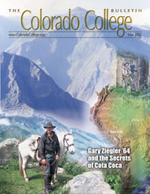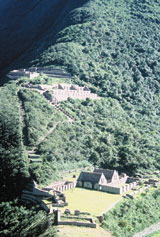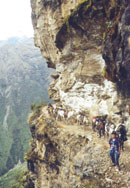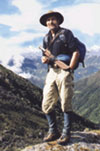
| NOVEMBER 2002 |
Secrets of Cota Coca
Globe-trotting explorer unearths ancient Inca wonders in Peru
By Scott Smith '76 This is all you need to know about Gary Ziegler '64: When asked
to describe a perfect day, the 61-year-old adventurer spontaneously
recites a to-do list that stretches into weeks and months, if
not years and lifetimes.
This is all you need to know about Gary Ziegler '64: When asked
to describe a perfect day, the 61-year-old adventurer spontaneously
recites a to-do list that stretches into weeks and months, if
not years and lifetimes. Ziegler's ideal day: doing summertime chores at his sprawling Bear Basin Ranch in the Wet Mountains, climbing a few challenging peaks, taking extended horse-pack trips into his favorite valleys in the nearby Sangre de Cristos, and exploring the machete-worthy wilderness of Peru in search of hidden history.
Long day, eh?
But that's quintessential Ziegler. He's a man who prefers to live life full to the brim -- and it's OK if some of it slops over the side and splashes onto his well-traveled boots. He's equal parts archaeologist, explorer, rancher, and entrepreneur -- and he's happiest when he's pokingg around somewhere he's never been before. Somewhere like Cota Coca.
Cota Coca?
It's a quiet little place tucked away in a remote valley in the forested heart of Peru's Andes Mountains -- and it's a place that Ziegler literally has helped to put on the map. In April, Ziegler and British explorer Hugh Thomson led an expedition that discovered the new Inca site that experts are calling a major find in the realm of Peruvian archaeology.
The discovery of Cota Coca in Peru's Vilcabamba region was the ultimate payoff for Ziegler, who has been systematically exploring the area for much of the past decade. Cota Coca is located about 25 miles away from the well-known ruins of Machu Picchu.
"It was exciting," says Ziegler, relaxing on the deck of his Bear Basin home just east of Westcliffe. "We've had some wonderful trips, but we've never really walked into something like this before, where there were so many structures. Then, as we opened it up and mapped it and started amassing data, we had the realization that this was a really important site. It's one of the missing pieces in the puzzle of this area."
 Cota Coca is a collection of at least 30 stone structures, including
a 75-foot-long kallanka (a meeting hall and administrative building),
clustered around a central plaza. Ziegler's crew also found
what they believe to be the remnants of a water canal and two
large, walled enclosures that may have been used as holding
pens for passing llama trains. The settlement was probably abandoned
around 1572, says Ziegler, when the last Inca was captured by
Spanish invaders.
Cota Coca is a collection of at least 30 stone structures, including
a 75-foot-long kallanka (a meeting hall and administrative building),
clustered around a central plaza. Ziegler's crew also found
what they believe to be the remnants of a water canal and two
large, walled enclosures that may have been used as holding
pens for passing llama trains. The settlement was probably abandoned
around 1572, says Ziegler, when the last Inca was captured by
Spanish invaders. The heretofore unknown site, located in a nearly inaccessible valley in the Andes at an elevation of about 6,000 feet, was found after a tip from a local mule driver. Cota Coca had been concealed for centuries, obscured by trees, bushes and underbrush and isolated by a rugged terrain made even more so by years of erosion by the Yanama River.
"The vegetation was so thick in places, you could be 3 feet away and not recognize a house or a wall; they were just completely covered," says Ziegler, who has been seeking Inca sites since the 1960s.
"We split into four teams, and we were all scrambling through the bushes with our neat little radios, and it was like, Look what I've got here!? There were literally structures popping out of the woods. This site was overwhelming."
Ziegler stressed that the discovery is "small potatoes" compared to other Inca sites, such as Machu Picchu or the lesser-known Choquequirao. But he also calls it "one of the most important sites found in recent decades," due both to its scope and condition.
"Of importance to us, the site hasn't been looted," he says. "Almost everything we've found in the past has been heavily looted, holes dug and walls knocked in."
 But Cota Coca is not exactly an easy stroll from the nearest
village, which is a tough two-day hike away. Indeed, just getting
to the site was an adventure in itself. Ziegler says it took
the party, which included three "archaeo-tourists" (the underwriters
of much of the trip's cost), eight mule handlers, 16 mules,
and seven horses, four or five days to hike into this area of
the Vilcabamba. Among the trek's challenges: traversing a 15,000-foot
mountain pass, making a muddy, 5,000-foot ascent of a steep
canyon, building trails where none previously existed, clearing
away thorny acacia trees with machetes, keeping an eye out for
occasional landslides and coping with swarms of black, biting
gnats.
But Cota Coca is not exactly an easy stroll from the nearest
village, which is a tough two-day hike away. Indeed, just getting
to the site was an adventure in itself. Ziegler says it took
the party, which included three "archaeo-tourists" (the underwriters
of much of the trip's cost), eight mule handlers, 16 mules,
and seven horses, four or five days to hike into this area of
the Vilcabamba. Among the trek's challenges: traversing a 15,000-foot
mountain pass, making a muddy, 5,000-foot ascent of a steep
canyon, building trails where none previously existed, clearing
away thorny acacia trees with machetes, keeping an eye out for
occasional landslides and coping with swarms of black, biting
gnats. For Ziegler, some of the hardest work began once the site had been discovered. After the group worked hard to clear away some of the layers of vegetation, Ziegler spent most of his two days at Cota Coca walking around with clipboard, graph paper, and pencils, mapping the structures in detail.
The group also spent plenty of time immersed in civilized speculation (sometimes over pre-dinner martinis and popcorn) regarding the site's meaning in the Incan scheme of things. Ziegler surmises that Cota Coca was a link with other Inca settlements in the area, including the mountain city of Choquequirao, and functioned as an administrative center that controlled access on a nearby Inca road through the Yanama valley.
It's likely that the Incas used the site during their period of retreat from the Spanish, probably in 1532-72, Ziegler says.
"I think this was a major portal in and out of the region and a way to raid colonial Peru without the Spanish finding it," he says.
Ziegler says the name Cota Coca goes back to at least the early 19th century and may have been the Incas' original name for the area. Its literal translation from Incan language is "tree of coca," indicating that the coca plant then reserved for high-status Incas might have been cultivated there.
 Cota Coca also is significant for its examples of late-Inca
masonry and there's no telling what else might be found once
serious excavation work begins. There might be prized pottery
or a nearby cemetery site, but Ziegler says he won't be around
for those potential discoveries.
Cota Coca also is significant for its examples of late-Inca
masonry and there's no telling what else might be found once
serious excavation work begins. There might be prized pottery
or a nearby cemetery site, but Ziegler says he won't be around
for those potential discoveries. "I'd rather be exploring than excavating," he says. "I wouldn't want to go and camp there for three weeks when there's so much to be found out there. To me, that's where the excitement is."
These days, Ziegler is back home at Bear Basin temporarily, of course, but he's still immersed in Cota Coca. There are hundreds of e-mails to answer, media interviews to deal with, notes to sort through (and articles to write), and ranch work to attend to. The discovery already has made headlines in everything from the Los Angeles Times to Reuters news service, and a press release issued by the Royal Geographical Society has christened Cota Coca "an important discovery."
It's all pretty heady stuff for Ziegler, whose 15 minutes of fame may be destined to last much longer. But, although pleased with his accomplishment, he remains nonplussed over the hoopla. After all, there's still plenty of Peru to peruse and that remains a priority for Ziegler.
The simple truth: Ziegler is as enamored with the Incas and Peru as he was nearly four decades ago, when he first visited the South American country he describes as "one of the most exciting, romantic, and mysterious places on Earth."
A Colorado Springs native, Ziegler graduated from Colorado College in 1964 with a love of climbing, lots of training in geology, a degree in philosophy, and a commitment to the Army (through ROTC). After graduation, he traveled to Peru for an American Alpine Club-sponsored ascent of an unclimbed peak (which remained unclimbed, because the expedition went up the wrong peak) and fell in love with the place.
Ziegler stayed in Peru, earned a doctorate in archaeology and developed an intense curiosity about the Inca culture. His archaeology career was interrupted by a three-year stint with the U.S. Army Special Forces in Vietnam, though, and when he returned from the war, he decided to forge a new career path. He bought the first piece of what would become Bear Basin Ranch, worked as an Outward Bound instructor, met his wife, Amy Finger, and founded Adventure Specialists Inc. in 1980, long before the adventure-tourism business was a mainstream endeavor.
Ziegler and Finger offer a variety of wilderness hikes, guided climbs, horse trips, and research adventures in Colorado, Mexico's Copper Canyon, and, of course, Peru.
"It's a lifestyle thing," says Ziegler of his business. "It provides very little income."
But it does provide the opportunity for his continued exploration of Peru, usually at least twice a year. And he's already contemplating his next excursion to somewhere he's never been before.
"We have a lot of X's on the topo map of where to go next," Ziegler says with a secretive smile. "All in Peru."
Scott Smith '76 writes for the Pueblo Chieftain. Reprinted with permission from the Pueblo Chieftain.
Thomson-Ziegler Peruvian Andes Expedition 2003
By Lisa Ellis '82"Travel is by mule, machete, and foot along steep, often treacherous, muddy paths descending thousands of feet into tropical, steamy lowlands then climbing steeply to precipitous highs over snow-covered passes."
--Quoted from "Beyond Machu Picchu: Exploration and Adventure in Peru's Remote Vilcabamba," by Gary Ziegler.
 Gary Ziegler and fellow explorer Hugh Thomson will return to
Peru in May 2003 to make a more thorough examination of the
Cota Coca area. They hope to uncover Inca sites that may lie
hidden beneath the cloud forest that covers the region where
the Andes slope down toward the Amazon.
Gary Ziegler and fellow explorer Hugh Thomson will return to
Peru in May 2003 to make a more thorough examination of the
Cota Coca area. They hope to uncover Inca sites that may lie
hidden beneath the cloud forest that covers the region where
the Andes slope down toward the Amazon. "We plan to reexamine several areas near Machu Picchu that Hiram Bingham visited following his initial discovery of [the famous site]. We believe from Hugh's recent research at the Bingham archives at Yale that an important site associated with Machu Picchu has yet to be found and studied," says Ziegler.
This time Ziegler, Thomson, and members of the expedition team will use a new technique to identify previously undiscovered Inca sites. The new tool is thermal imaging. Ziegler and Thomson plan to systematically scan the projected mountain and ridges with thermal imaging from satellite, and possibly aircraft sensors, prior to returning for field investigation.
"This may save us days of hacking about with machetes in dense cloud forest vegetation, allowing our limited time and energy to be directed to clearing, mapping, and studying the remotely located sites," says Ziegler.
Archaeologists, scientists, expedition sponsors, and other interested parties will be able to follow expedition progress on a daily basis via the Internet. Visit www.adventurespecialist.org to stay abreast of one of the most exciting expeditions ever mounted to look for Inca ruins.
Go back to the Bulletin main page.